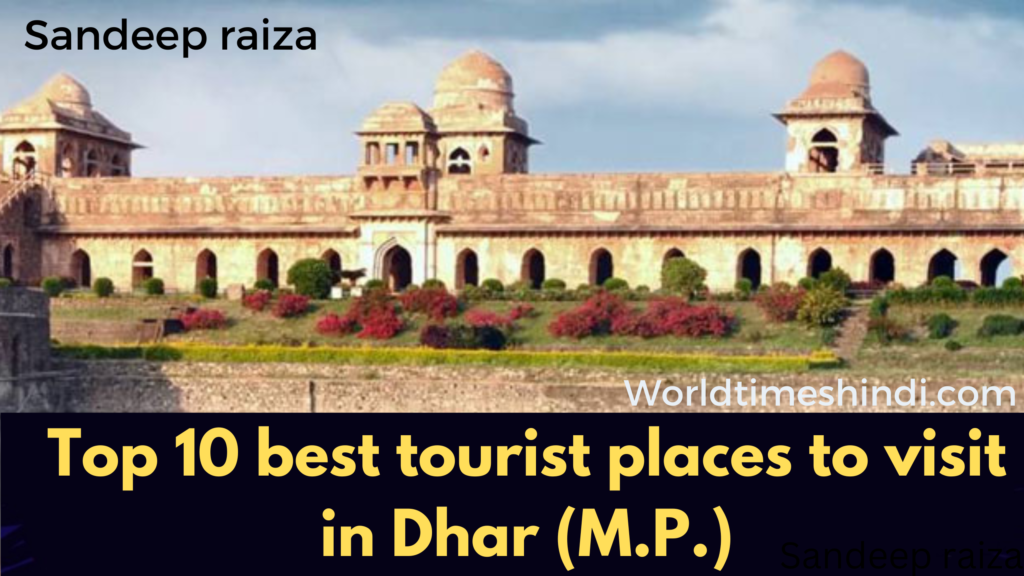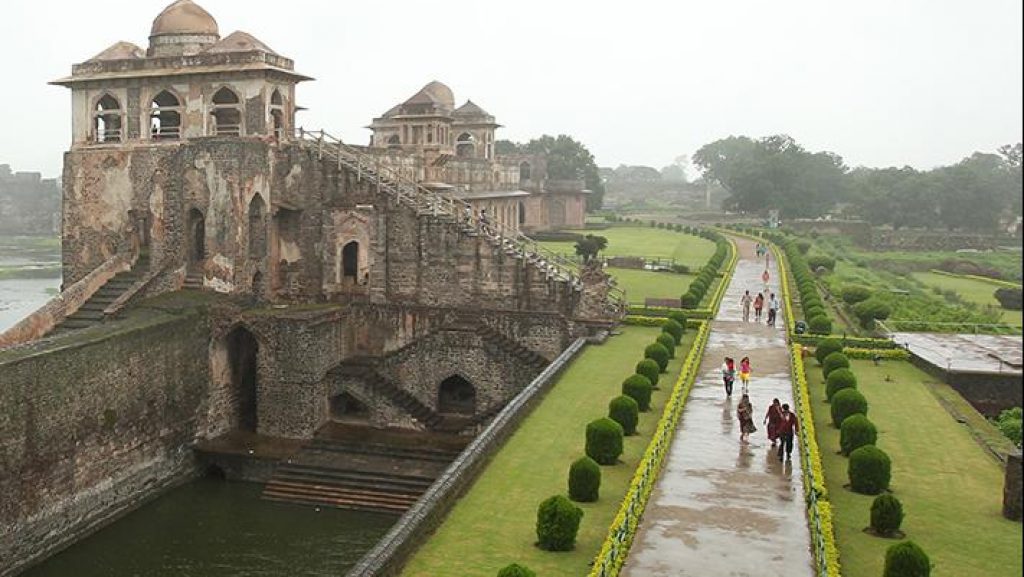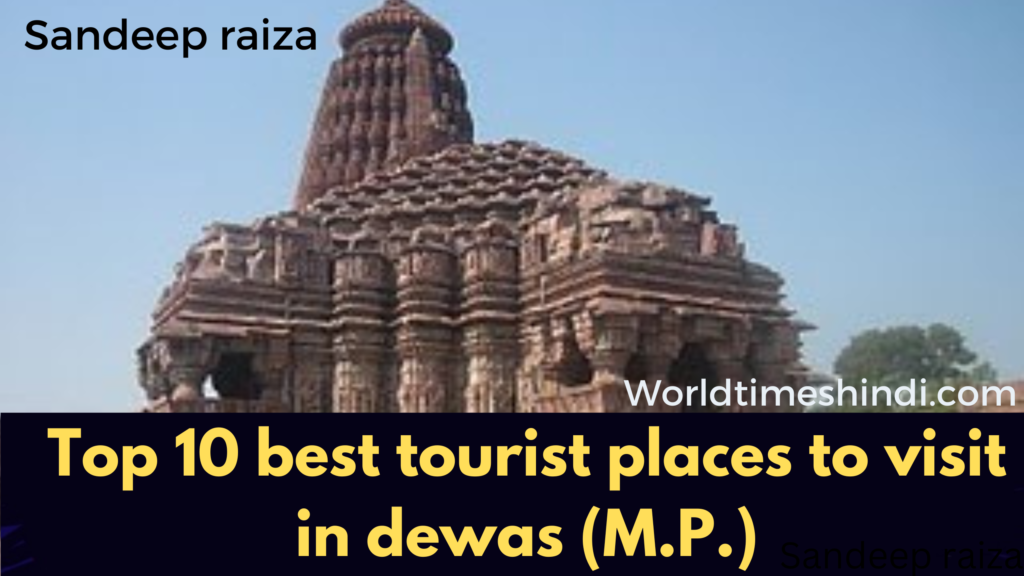History of Dhar
The Paramaras ruled over a vast territory around Malwa for 400 years from the 9th to the 13th centuries. Vakpati Munja and Bhojadeva were the most famous rurlers of this dynasty. Munja was a great general, a poet of repute and a great patron of art and literature. His court was adorned by poets like Dhananjaya, Halayudha, Dhanika, Padmagupta, the author of Navasahasankacharita, Amitagati, etc. He excavated the Munja Sagar at Dhar and Mandu and built beautiful temples at a number of places.

Bhojadeva, the most illustrious of the Parmaras, was one of the greatest kings of ancient India. His name became a household word in India not only as a soldier but also as a builder, a scholar and a writer. Authorship of a large number of books on a variety of subjects like gramer, astronomy, poetics, architecture and asceticism is ascribed to him. He shifted his capital from Ujjain to Dhar, where the established a university for Sanskrit studies. It is known as the Bhoja Shala in which was enshrined the image of Goddes Saraswati. He rebuilt temples, including the magnificient temple at Bhojapur. Bhoja also created a large lake near Bhojapur.
In the year 1305, A.D. the whole of Malwa passed into the hands of Al-ud-din Khalji when Dhar and Mandu were also captured. Dhar continued to be under Delhi Sultans until the reign of Muhammed II. At that time, Dilawar Khan Ghuri was the Governor of Malwa. In 1401 A.D. he assumed royality and established an independent Kingdom of Malwa, with his capital at Dhar. His son and successor, Hoshang Shah moved the capital to Mandu. Hoshang Shah died in 1435 A.D. and was entomed in the splendid mausoleum which is still existing at Mandu. On Hoshang’s death his son, Ghazni Khan, succeeded him. He ordered his capital Mandu to be called “Shadiabad (the City of Joy).
He, however, had a very short reign, as he was poisoned to death by Mahmud Khalji in 1436 A.D. Mahmud Khan ascended the throne and inaugurated the reign of the Khalji Sultans in Malwa. Khalji Sultans continued to rule Malwa till 1531 A.D. Later Malwa was captured by Sher Shah and was placed under the charge of Shujat Khan. Shujat Khan was succeeded by his son Baz Bahadur. Mandu and its environs reverberated with the stories of romance of Rupmati and Baz Bahadur. When Baz Bahadur was defeated and put to fight by the Mugal army, his beloved Rupmati took poison and put an end to her life to escape dishonour.
In the administrative organisation of Akbar, Dhar was the Chief town of a Mahal in Mandu Sarkar of the Subah of Malwa. Akbar stayed at Dhar for seven days, while directing the invasion of the Deccan. He also visited Mandu a number of times. Mandu was also a favourite resort of Emperor Jahangir, who stayed here for over six months in 1616 A.D. In his memoirs, Jahangir has payed glowing tributes to the pleasant climate and prety scenery at Mandu Noorjahan shot four tigers with six bullets, from the back of an elephant, near Mandu.
When Baji Rao Peshwa divided Malwa among Sindhia, Holkar and the three Pawar Chief, in 1832 A.D. Dhar was bestwed on Anand Rao Pawar. The rulers of Dhar held away over this area till 1948, except for a brief period of three years, following the grat Revolt of 1857.
Dhar was an important centre of Revolt, during the First War of Independence in 1857. Freedom fighters captured the Fort of Dhar which remained in their possession from July to October, 1857. The Bhils also took active part in the Revolt. The rebels paralysed the authority of the State and opposed the British. Consequently, a large force marched against Dhar under Colonel Durand, and captured the town. Just because three or four rounds were fired on the British troops by rebels, the British soldiers took a tribal revenge on the local people. They dragged civilians from their houses, killed them and looted their property ladies were dishonoured. The rebels defended the fort, till 31st October, 1857 when breach was caused. They, therefore, escaped through an underground passage.
As an aftermath of the Revolt, Dhar State was annexed to the British terriory. The British Government however, changed the decision of Government of India, and restored Dhar to Anand Rao III, on the 1st may 1860.
Mandu, clothed in green, with turbulent brooks and torrents rushing down into the encircling ravines, presents a magnificent spectacle. Thousands of tourists are drawn to Mandu, to have a glimpse of the splendid movements there.
Another place of great national importance is Bagh, where the caves have been excavated on the rockface of a lofty hill, on he bank of the Bagh river. The paintings at Bagh date back to a period between the 5th and the 7th centuries A.D., the Golden Age of Indian Art. Together with the Ajanta paintings, the Bagh paintings represent the finest traditions of Indian Art, which had a far-reaching influence on the Buddhist Art, not only in India, but on the entire Buddhist Art in Asia.
The majority of the population in Dhar District belongs to the Scheduled Tribes. The main tribes in the District are Bhils and Bhilalas. Their highest concentration is in Kukshi Tahsil.
Quick fact’s about Dhar
- Total Area: 8153 sq. KM.
- Population: 2,185,793
- Official language: Hindi
- Population Growth: 25.60%
- Vehicle registration: MP-11
- Pincode : 454001
9 Best tourist places to visit in Dhar
1. Roopmati’s Pavilion , Dhar

A large sandstone structure originally built as an army observation post it is known today as Roopmati’s Pavilion. Rani Roopmati – the love interest of Baaz Bahadur lived here and is said to have gazed at the Baz Bahadur’s Palace – situated below and also at Narmada river, flowing through the Nimar plains far below, a river which the queen revered.
2. Hindola Mahal

Hindola Mahal – meaning Swing palace is so named due to its sloping side walls. The Hindola Mahal might have been constructed during the reign of Hushang Shah about 1425 C.E. but may date to the end of the 15th century during the reign of Ghiyas al-Din.
It is one of a set buildings making up the royal palace complex at Mandu, which consists of the Jahaz Mahal, the Hindola Mahal, the Taveli Mahal, and the Nahar Jharokha. The Hindola Mahal may have been used as an audience chamber.
3. Jahaz Mahal (Ship Palace)

Situated between two artificial lakes, this two-storied architectural marvel is so named as it appears as a ship floating in water. Built by Sultan Ghiyas-ud-din-Khalji, it served as a harem for the sultan. This is The Water Palace shown in Fisher’s Drawing Room Scrap Book, 1832 together with a poetical illustration by Letitia Elizabeth Landon.
4. Dhar Fort

The history of Dhar Fort suggests that the historical monument was the capital of the legendary king named, King Bhoj. From the central area of the town, Dhar Fort is situated for over 3 kms away. At the time, when Delhi was powered by Alauddin Khalji, Islamic influence started spreading in Dhar. During his time, it was Alauddin Khalji who took the initiative of the construction of the Dhar Fort. It was in the year 1344 that the work was finished and it still stands strong as the passage for so many years.
For you kind information, Dhar Fort gets open at 06.00 AM and closes at 07.00 PM. There is no entry fee to explore this lovely fort. The average time spent at Dhar Fort is 30 minutes. Moreover, the busiest days at the fort happen to be Monday, Wednesday and Saturday.
5. Bagh caves, Dhar

Bagh Caves is located on the banks of Baghani River in the Dhar district of Madhya Pradesh. The rock cut caves of this beauty place possess the most astonishing paintings known to be made by ancient man. It is also to be noted here that out of the initial 9 caves only 5 caves are extant today. The caves were carved in the late 4th century – 6th century AD, and were built by Buddhist monk, Dataka. It is also to be mentioned here that when Bagh Caves, Dhar was discovered; only cave no. 3 and cave no. 4 had endured the ravages of time. Topping it all, the frescoes of Bagh unquestionably epitomise the ‘golden age’ of Indian classical art.
It is to inform all the travellers that Bagh Caves are open 24 hours and the exact location is Bagh Cave Road, Naingaon, Dhar, Madhya Pradesh 454221. Apart from this, if you are wondering as to if there is any entry fee, then yes, it is INR 5 per Indian and SAARC countries adults. It is noticed that Bagh Caves will take 2 hours of your time in order to enjoy the beauty of this place. Bagh Caves is for around 120 kms from Mandu bus stand.
6. Jhira Bagh Palace, Dhar

Jhir Bagh Palace is a beautiful palace that is nestled in the picturesque and lush green gardens all over. In addition to this, Jhira Bagh Palace, Dhar is a tall and royal property that lies in the very heart of the Malwa Plateau, in West Madhya Pradesh. We won’t be wrong if we say that the Jhira Bagh Palace is a prized and cherished palace that continues to reverberate in its walls. Due to its amazing architecture and outstanding atmosphere, every traveller must keep Jhira Bagh Palace in their itinerary to witness what royalty is.
7. Baz Bahadur’s Palace, Dhar

You must be thinking who was Baz Bahadur? He was the sultan of this city from 1555 to 1561. It was during his reign, Mandu reached its highest grandeur. But he has built the palace much before he became a king i.e. in 1509. This beautiful edifice was built on the hill and beneath lies the Rewa Kund, which is used as a water supply source.
Entry to the Baz Bahadur’s Palace is not free for the tourists. The charges are as below –
• Indian tourists – 5 Rs
• Foreigner tourists – 100 Rs
• Video camera – 25 Rs
8. Rani Roopmati’s Pavilion, Dhar

Immortalized for the legendary Baz Bahadur and Rani Roopmati love story, this beautiful piece of architecture is one of the most visited tourist places in Mandu. If history is to be believed, this pavilion was built by Malwa sultan Baz Bahadur to show his love and devotion for his beloved Rani Roopmati, a very beautiful Hindu classical singer.
As per folklore, Roopmati agreed to go to Mandu with sultan Baz Bahadur on the condition that she would stay in such a palace from where she could see her beloved sultan’s residence and river Narmada. The beautiful love story of ended tragically owing to the intrusion of Adham Khan, a general in Mughal emperor Akbar’s royal army, who tried to take possession of Baz Bahadur’s lady love Rani Roopmati. When Adham Khan defeated Baz Bahadur in the war, Rani Roopmati preferred to poison herself to avoid capture.
Timings: 8 am to 7 pm
• Visiting duration: approximately 1 hour
• Entry fee:
• Rs 5 for Indians
• Rs 100 per person for foreigners.
• Rs 25 for video cameras
9. Jahaz Mehal , Dhar

Jahaz Mehal was built during the reign of Mandu Sultan Ghiyas-ud-din Khilji, somewhere around 1436-1439, to accommodate his 15000 concubines. This magnificent pleasure palace was constructed to keep the women belonging to the royal consortium hidden from public view. Here, Sultan’s consorts enjoyed a life of luxuries and opulence. In1617 Mughal emperor Jahangir visited this magnificent ship palace with his favorite wife Nur Jahan and later described his experience of staying in this place as ‘a wonderful assembly’.
• Timings: 6 AM to 67 PM on all days of the week.
• Entry Fee:
• Indian tourist: INR 5
• Foreigner: INR 100
• Video camera: 25
• Visiting duration: 1 to 2 hours.
Famous dessert in Dhar
Daal, Baati

Daal Bati or Bafla is a traditional meal of Dhar which is preferred in both urban and rural areas. It is easily available in most restaurants and hotels.
Dhar is a part of Malwa region. Dal Baati is comprising Dal (lentils) and Baati (hard wheat rolls). It is popular in other part of Madhya Pradesh also.
Dal is prepared using Tuvaar Dal, Chana Dal (prepared by removing skin of split chickpeas), Mung dal. The pulses or lentils are cooked together after being soaked in water for a few hours. First, a small amount of vegetable oil is heated in a frying pan and then the seasoning rai-jeera (mustard and cumin seeds) is added into the hot oil. Then green chilli, garlic and some spices including hing, red chilli, haldi, coriander, ginger are added. There may be a sweet and sour version of dal in some regions. Finally, the boiled Daal is added and cooked.
Baati is a hard bread made up of wheat flour commonly known as aata. Wheat flour is kneaded with little bit of salt, Dahi (yogurt) and water. Tennis ball-sized round balls of this dough are cooked in a well-heated traditional oven. When the Baati becomes golden brown in colour, it is greased with ghee and is then served with dal, rava ladoo, rice, pudina chutney, kairi (raw mango) chutney, green salad with lots of onion, and fresh buttermilk (chass).
Dal Bafla is a variation of Dal Baati, where the normal Bafla is boiled before baking it in traditional Baati oven. Batti is replaced by the Bafla, a softer version of it.
How to Reach
By Air
Devi Ahilyabai Holkar Airport in Indore is the nearest airport. There are regular flights from Delhi, Mumbai, Pune, Jaipur, Hyderabad, Bhopal, Ahmedabad, Nagpur, Raipur and Kolkata
By Bus
Mandu is well connected from Indore (95 km) and Dhar (35 km). From Indore there are two direct bus to Mandu, the first from Gangwal Bus Stand (08:00) and second from Sarawate Bus Stand (14:00). The journey takes 3 hours.
Alternatively one can make a break journey at Dhar. There are regular bus service from Indore to Dhar and from Dhar to mandu.
By Car
You can rent a car in Indore. The best route from Indore is as follows: Indore – Betma – Ghatabillod – Dhar – Mandu. The distance is approximately 95 km and the roads are in good condition.
Where to stay hotel /Resort
MPT Malwa Retreat, Mandu
Mandu has been a pleasure resort of the Mughals due to its elevation and the beautiful monsoon. Since then the city attracts pleasure and leisure travelers and with MPSTDC’s Malwa Retreat, Mandu is your home in this city of joy. Malwa Retreat is a budget offering of MPSTDC.
Address: Main Road, Naka Main Road Mandu, Dhar, Madhya Pradesh PIN Code: 454020
Phone:07292-263221 Email:mretreatm@mpstdc.com
MPT Malwa Resort, Mandu
Malwa Resort, Mandu makes an ideal place to stay being ideally located from the monuments. The remarkable service and facilities offered, attracts both leisure and pleasure travellers.
Address: Roopmati Road, Mandu, Mandu, Madhya Pradesh PIN Code: 454020
Phone:07292-263235 Email:mresortm@mpstdc.com



